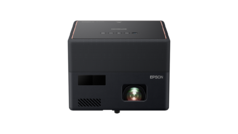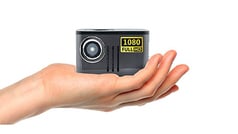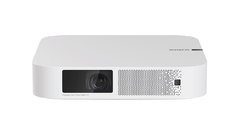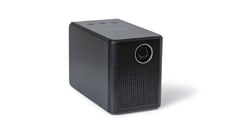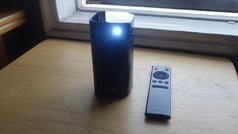
[ad_1]
The $599 LG CineBeam PF510Q projector is a solid choice among 1080p oversize palmtops. Compared with its most obvious competition, including the Xgimi Elfin—one of our top picks for a portable streaming home-entertainment model—it offers a taller profile with a smaller footprint, giving it a slightly boxier shape than typical. However, it weighs only a touch more than the Elfin, and although it’s not as bright, it offers one key feature that almost all other models in this category lack: a LAN port for wired connection to a network (in addition to Wi-Fi support). For those who prefer Ethernet connections—which are still a lot easier to set up than Wi-Fi, as well as more reliable and more secure—that alone makes the PF510Q particularly worth considering.
No Battery, No Problem
One potentially important feature the PF510Q doesn’t offer is an onboard battery, a design choice it shares with the Elfin. In the Elfin’s case, being limited to AC power is a result of the projector offering an unusually bright, power-hungry image for its size. In the PF510Q’s case, the brightness rating is a touch higher than typical, but not by much, at 450 ANSI lumens. However, being limited to AC power still makes a lot of sense because of the LAN port. Quite simply, whatever a projector’s size, if you’re using a wired network connection, you’re almost certainly going to be near a power outlet when you connect.
That said, it’s easy to find battery-powered models in this weight class, including the Anker Nebula Solar Portable, also one of our top choices for an oversize palmtop, and the somewhat-more-expensive Anker Nebula Capsule 3 Laser, our current top pick for best image quality for a portable streaming home entertainment projector.

(Credit: LG)
The PF510Q is built around a 1080p (1,920-by-1,080-pixel) DLP imaging chip and a four-channel LED light source with red, green, and two blues (RGBB). LG rates it at 30,000 hours in full power mode. The projector lacks support for 4K input, but there is support for HDR, which worked nicely in my tests with HDR10.
Similar Products
At 2.6 by 5.8 by 5.8 inches (HWD) and 2.2 pounds, the PF510Q is compact enough to fit easily in a briefcase or backpack, or on a bookshelf when not in use, ready for quick setup when needed. However, no protective case comes with the projector. If you plan to carry it anywhere beyond one room to another, you might want to get one separately.

(Credit: LG)
Physical setup is mostly straightforward. Connect to an image source, turn the power on, adjust the image size by moving the projector, and manually focus. The last step is harder than it should be, though, because the focus changes a lot with very little movement of the focus control. After several tries, I managed to get a highly watchable image, albeit one with somewhat of a soft focus. Connection options besides Ethernet and Wi-Fi include two HDMI ports and Wi-Fi Direct, which I found unusually easy to set up for mirroring my Android phone.
One welcome touch is that LG webOS 22, unlike Android TV, doesn’t require any setup. You have to pick which streaming apps to use and sign into each individually, of course, but you don’t have to set up anything to get to the point where you can do that. From the first time you turn on the projector, the streaming features are ready to go. There’s no Netflix app, however, so if Netflix is a must-have, you’ll either have to look elsewhere, or connect to another source to get it.

(Credit: LG)
The built-in 5-watt mono speaker delivers usable sound quality, but at barely high-enough volume for a small room. Options for connecting to an external sound system include Bluetooth, DLNA, and a 3.5mm audio-out port. For Bluetooth, there’s also a sync adjustment to match the audio to the video—an unexpected bonus for this class of projector.
Testing the CineBeam PF510Q: Cinema Is Best
For SDR input, the PF510Q offers eight picture modes, including two labeled Expert (one is for daytime viewing and one for nighttime). Most people will consider any of them usable for presentations with graphics or even a few photorealistic images, but some were oversharpened, which can make text in documents and spreadsheets hard to read, and some showed an obvious color shift.
After some preliminary tests, I picked Cinema mode and either of the two Expert modes as the best—and equally good—choices both for presentations and for film and video. All three offered roughly equivalent image quality, avoiding oversharpening and delivering good color accuracy. Among them, you’ll want to choose the one that offers the best brightness level for the ambient light level and the image size you want to use. For our formal tests in a dark room, using a 1.0-gain 90-inch diagonal screen, I chose Cinema mode.

(Credit: LG)
Although the PF510Q delivered good color accuracy for our 1080p SDR viewing tests using movies on Blu-ray discs, it lost enough shadow detail in many darker scenes for even those who aren’t familiar with those images to notice. In the darkest scenes in our tests, it was impossible to make out what was happening. Fortunately, most movies and video have few or no scenes to match our darkest test clips, so this won’t be a problem in most cases. Even when it is a problem, most people will consider it tolerable for casual viewing.
The good news is that the PF510Q did a much better job handling the same dark scenes in the HDR versions of the same movies on disc. Its rendering with HDR still lost much of the shadow detail I know is in the scenes, but it kept enough so I could follow the action. Brighter scenes tended to be noticeably dimmer with HDR versions, however, which means you’ll probably want to stay with a smaller image size when watching HDR material. Note also that there is no 3D support.

(Credit: LG)
Under the category of unexpected extras, the menus include a Game Optimizer mode with four settings to chose from—Standard, FPS (First Person Shooter), RPG (Role-Playing Game), RTS (Real-Time Strategy) and Sports— to optimize settings for different types of games. However, I measured the input lag using a Bodnar meter at a lackadaisical 37.4 milliseconds with Game Optimizer mode set to FPS. Most casual users should find that acceptable, but serious gamers will consider it too long.
According to the Society for Motion Picture and Television Engineers standards, the rated 450 ANSI lumens is enough to light up a 97-inch screen. The lower-brightness Movie mode I used for testing was about as bright as I expect from about 300 lumens—suitable with lights off for the 90-inch screen I was using for my tests, but just barely, and also usable for an 80-inch screen in the low ambient light typical of a family room at night with a few lights on.
Verdict: Plug In and Stream
The LG PF510Q offers a robust set of features, most notably good color accuracy and HDR support worth having. If your projector having an Ethernet connection is a top priority, it’s a slam-dunk pick. But if you can do without Ethernet, it has some stiff competition. Be sure to also consider the Xgimi Elfin. It’s the brightest model mentioned here by far, rated at 800 ANSI lumens, although as with the LG projector, it lacks an onboard battery.
If you need the extra portability a battery gives you, consider the Anker Nebula Solar Portable or the Anker Capsule 3 Laser. The Solar Portable is less expensive, at about the same price as the PF510Q or the Elfin. The Capsule 3 Laser—the only one of these four that takes the form of a soda can rather than an oversize palmtop—is lighter and delivers better image quality.
All four models are good choices, however. Which one will be the best fit depends entirely on which features you deem most important. If you’re partial to the stability of wired network connectivity and you seek well-designed streaming features to take advantage of it, the PF510Q obliges.
3.5

(Opens in a new window)
(Opens in a new window)
View More
View More
The LG CineBeam PF510Q is a capable, lightweight palmtop projector that offers 1080p resolution, built-in streaming, and image quality suitable both for business presentations and video.
[ad_2]
Source link : https://www.pcmag.com/reviews/lg-cinebeam-pf510q
